A Comprehensive Exploration: CAM History and Philosophical Foundations
VerifiedAdded on 2021/04/17
|7
|1496
|59
Essay
AI Summary
This paper provides an in-depth exploration of the history and philosophy of complementary and alternative medicine (CAM). It begins by defining CAM and contrasting it with orthodox medicine, highlighting practices like massage and herbal remedies. The essay then delves into the core concepts of holism, which emphasizes the interconnectedness of body parts and treating the whole person, and vitalism, which posits a life force distinct from physical and chemical forces. The historical development of CAM is traced from ancient Greece and Rome, detailing the evolution of practices such as aromatherapy, reflexology, and massage therapy. The paper also examines the shift in medical practices and consumerism, highlighting the increasing popularity of CAM in the modern world, and provides references to support the discussion.
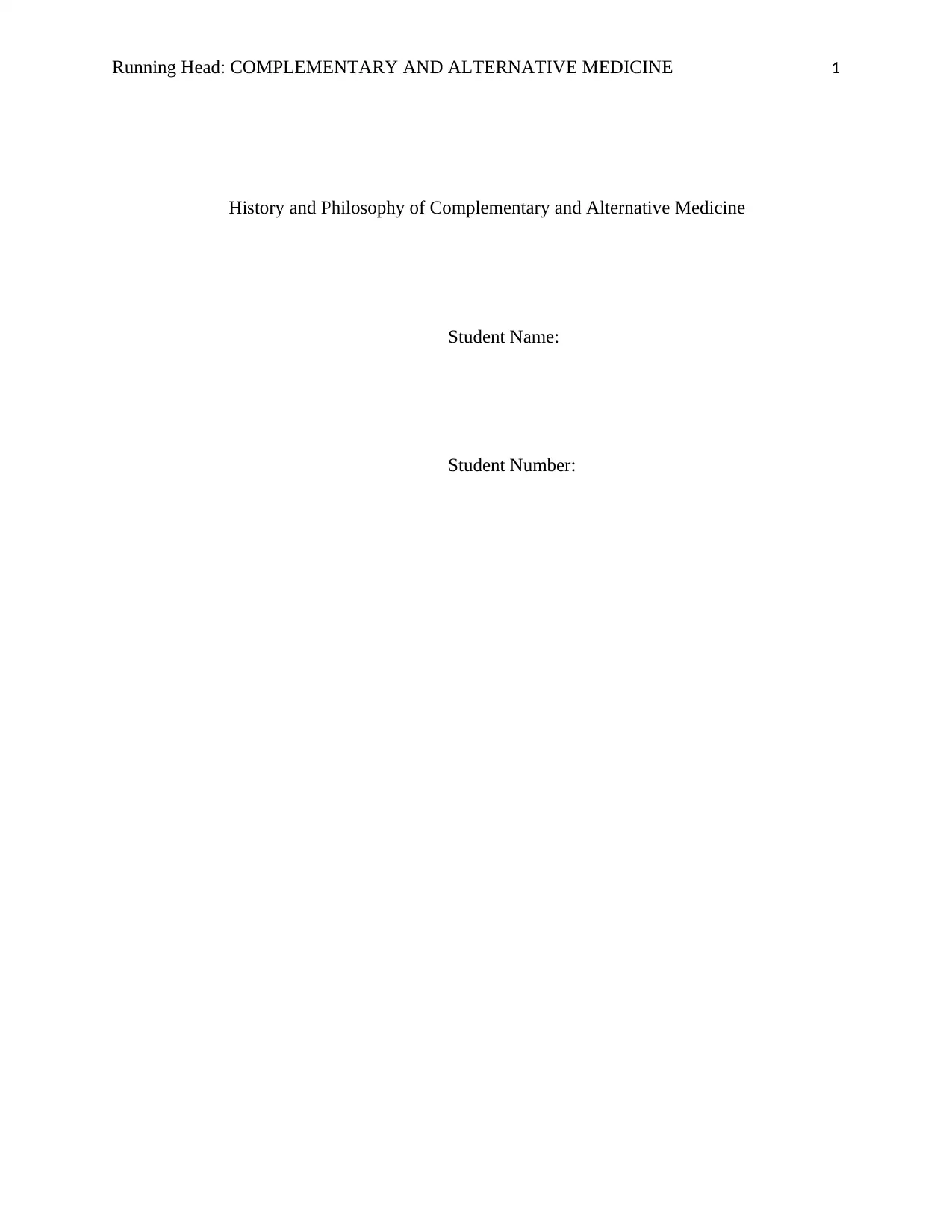
Running Head: COMPLEMENTARY AND ALTERNATIVE MEDICINE 1
History and Philosophy of Complementary and Alternative Medicine
Student Name:
Student Number:
History and Philosophy of Complementary and Alternative Medicine
Student Name:
Student Number:
Paraphrase This Document
Need a fresh take? Get an instant paraphrase of this document with our AI Paraphraser
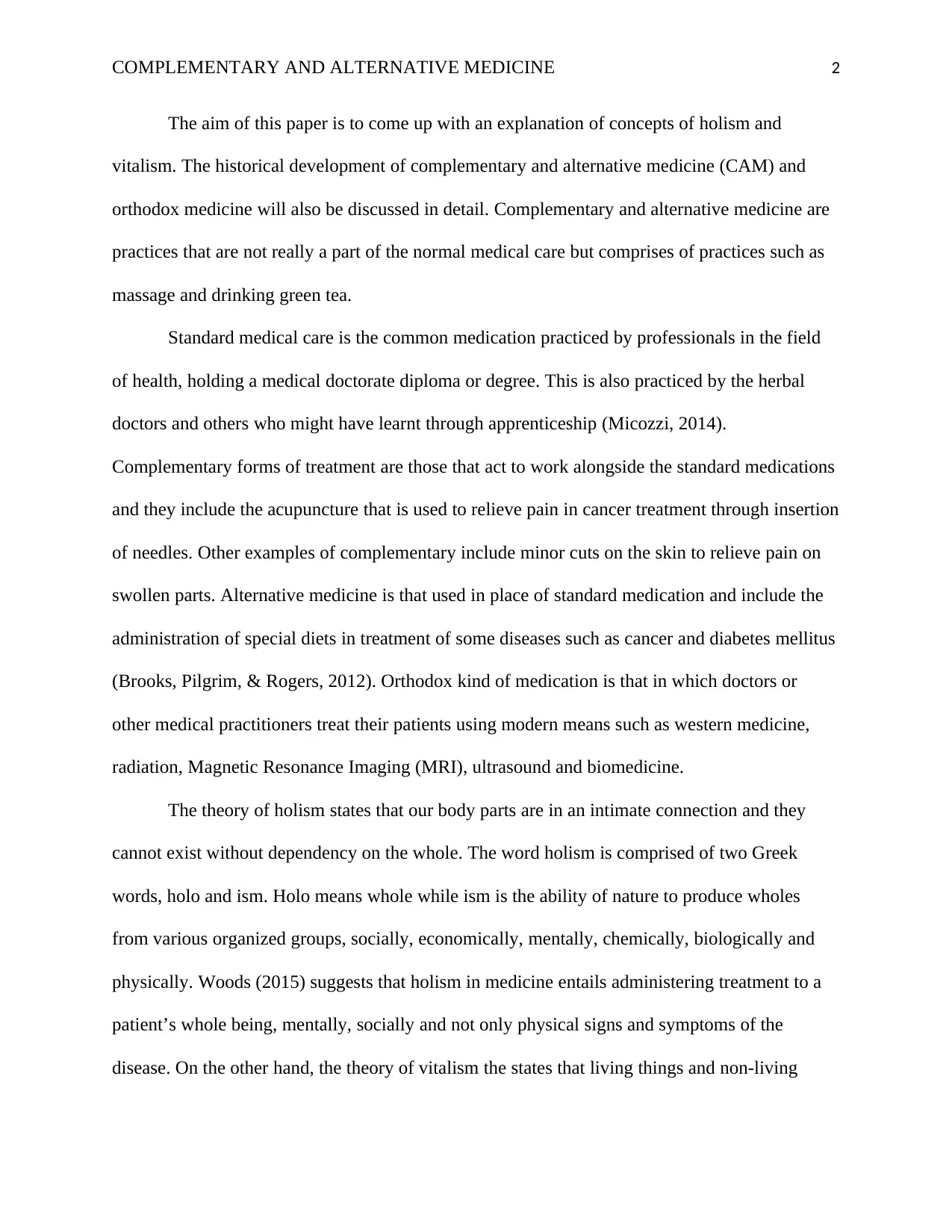
COMPLEMENTARY AND ALTERNATIVE MEDICINE 2
The aim of this paper is to come up with an explanation of concepts of holism and
vitalism. The historical development of complementary and alternative medicine (CAM) and
orthodox medicine will also be discussed in detail. Complementary and alternative medicine are
practices that are not really a part of the normal medical care but comprises of practices such as
massage and drinking green tea.
Standard medical care is the common medication practiced by professionals in the field
of health, holding a medical doctorate diploma or degree. This is also practiced by the herbal
doctors and others who might have learnt through apprenticeship (Micozzi, 2014).
Complementary forms of treatment are those that act to work alongside the standard medications
and they include the acupuncture that is used to relieve pain in cancer treatment through insertion
of needles. Other examples of complementary include minor cuts on the skin to relieve pain on
swollen parts. Alternative medicine is that used in place of standard medication and include the
administration of special diets in treatment of some diseases such as cancer and diabetes mellitus
(Brooks, Pilgrim, & Rogers, 2012). Orthodox kind of medication is that in which doctors or
other medical practitioners treat their patients using modern means such as western medicine,
radiation, Magnetic Resonance Imaging (MRI), ultrasound and biomedicine.
The theory of holism states that our body parts are in an intimate connection and they
cannot exist without dependency on the whole. The word holism is comprised of two Greek
words, holo and ism. Holo means whole while ism is the ability of nature to produce wholes
from various organized groups, socially, economically, mentally, chemically, biologically and
physically. Woods (2015) suggests that holism in medicine entails administering treatment to a
patient’s whole being, mentally, socially and not only physical signs and symptoms of the
disease. On the other hand, the theory of vitalism the states that living things and non-living
The aim of this paper is to come up with an explanation of concepts of holism and
vitalism. The historical development of complementary and alternative medicine (CAM) and
orthodox medicine will also be discussed in detail. Complementary and alternative medicine are
practices that are not really a part of the normal medical care but comprises of practices such as
massage and drinking green tea.
Standard medical care is the common medication practiced by professionals in the field
of health, holding a medical doctorate diploma or degree. This is also practiced by the herbal
doctors and others who might have learnt through apprenticeship (Micozzi, 2014).
Complementary forms of treatment are those that act to work alongside the standard medications
and they include the acupuncture that is used to relieve pain in cancer treatment through insertion
of needles. Other examples of complementary include minor cuts on the skin to relieve pain on
swollen parts. Alternative medicine is that used in place of standard medication and include the
administration of special diets in treatment of some diseases such as cancer and diabetes mellitus
(Brooks, Pilgrim, & Rogers, 2012). Orthodox kind of medication is that in which doctors or
other medical practitioners treat their patients using modern means such as western medicine,
radiation, Magnetic Resonance Imaging (MRI), ultrasound and biomedicine.
The theory of holism states that our body parts are in an intimate connection and they
cannot exist without dependency on the whole. The word holism is comprised of two Greek
words, holo and ism. Holo means whole while ism is the ability of nature to produce wholes
from various organized groups, socially, economically, mentally, chemically, biologically and
physically. Woods (2015) suggests that holism in medicine entails administering treatment to a
patient’s whole being, mentally, socially and not only physical signs and symptoms of the
disease. On the other hand, the theory of vitalism the states that living things and non-living
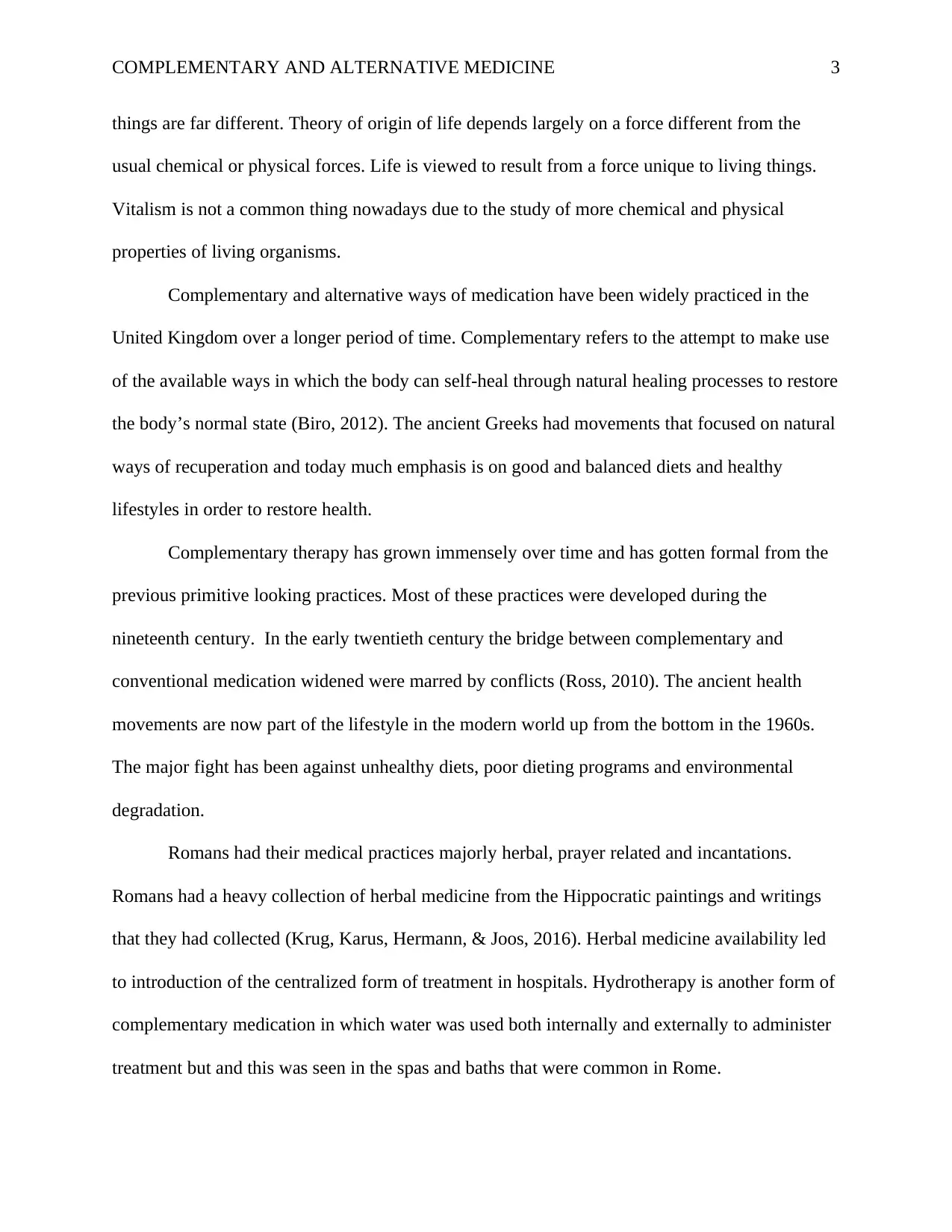
COMPLEMENTARY AND ALTERNATIVE MEDICINE 3
things are far different. Theory of origin of life depends largely on a force different from the
usual chemical or physical forces. Life is viewed to result from a force unique to living things.
Vitalism is not a common thing nowadays due to the study of more chemical and physical
properties of living organisms.
Complementary and alternative ways of medication have been widely practiced in the
United Kingdom over a longer period of time. Complementary refers to the attempt to make use
of the available ways in which the body can self-heal through natural healing processes to restore
the body’s normal state (Biro, 2012). The ancient Greeks had movements that focused on natural
ways of recuperation and today much emphasis is on good and balanced diets and healthy
lifestyles in order to restore health.
Complementary therapy has grown immensely over time and has gotten formal from the
previous primitive looking practices. Most of these practices were developed during the
nineteenth century. In the early twentieth century the bridge between complementary and
conventional medication widened were marred by conflicts (Ross, 2010). The ancient health
movements are now part of the lifestyle in the modern world up from the bottom in the 1960s.
The major fight has been against unhealthy diets, poor dieting programs and environmental
degradation.
Romans had their medical practices majorly herbal, prayer related and incantations.
Romans had a heavy collection of herbal medicine from the Hippocratic paintings and writings
that they had collected (Krug, Karus, Hermann, & Joos, 2016). Herbal medicine availability led
to introduction of the centralized form of treatment in hospitals. Hydrotherapy is another form of
complementary medication in which water was used both internally and externally to administer
treatment but and this was seen in the spas and baths that were common in Rome.
things are far different. Theory of origin of life depends largely on a force different from the
usual chemical or physical forces. Life is viewed to result from a force unique to living things.
Vitalism is not a common thing nowadays due to the study of more chemical and physical
properties of living organisms.
Complementary and alternative ways of medication have been widely practiced in the
United Kingdom over a longer period of time. Complementary refers to the attempt to make use
of the available ways in which the body can self-heal through natural healing processes to restore
the body’s normal state (Biro, 2012). The ancient Greeks had movements that focused on natural
ways of recuperation and today much emphasis is on good and balanced diets and healthy
lifestyles in order to restore health.
Complementary therapy has grown immensely over time and has gotten formal from the
previous primitive looking practices. Most of these practices were developed during the
nineteenth century. In the early twentieth century the bridge between complementary and
conventional medication widened were marred by conflicts (Ross, 2010). The ancient health
movements are now part of the lifestyle in the modern world up from the bottom in the 1960s.
The major fight has been against unhealthy diets, poor dieting programs and environmental
degradation.
Romans had their medical practices majorly herbal, prayer related and incantations.
Romans had a heavy collection of herbal medicine from the Hippocratic paintings and writings
that they had collected (Krug, Karus, Hermann, & Joos, 2016). Herbal medicine availability led
to introduction of the centralized form of treatment in hospitals. Hydrotherapy is another form of
complementary medication in which water was used both internally and externally to administer
treatment but and this was seen in the spas and baths that were common in Rome.
⊘ This is a preview!⊘
Do you want full access?
Subscribe today to unlock all pages.

Trusted by 1+ million students worldwide
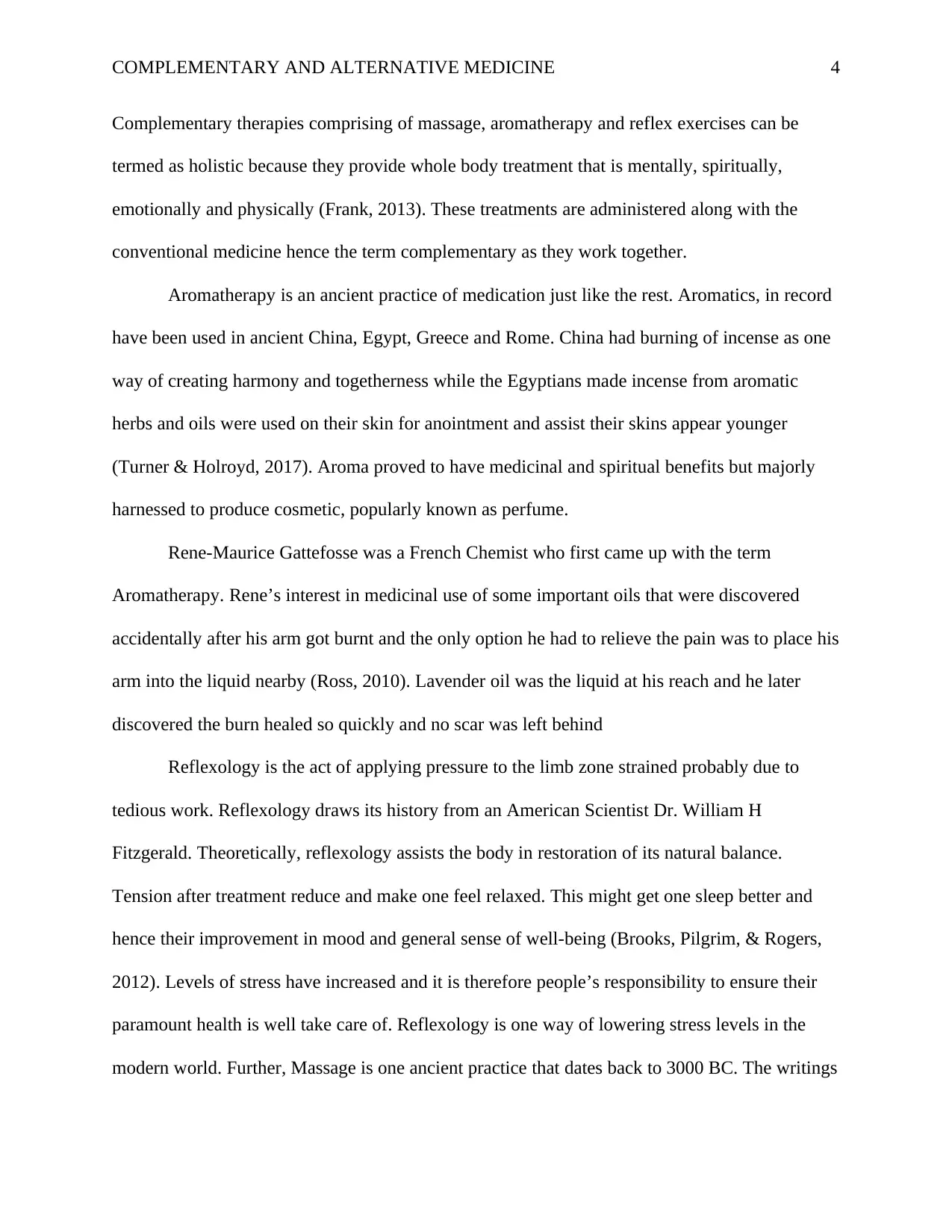
COMPLEMENTARY AND ALTERNATIVE MEDICINE 4
Complementary therapies comprising of massage, aromatherapy and reflex exercises can be
termed as holistic because they provide whole body treatment that is mentally, spiritually,
emotionally and physically (Frank, 2013). These treatments are administered along with the
conventional medicine hence the term complementary as they work together.
Aromatherapy is an ancient practice of medication just like the rest. Aromatics, in record
have been used in ancient China, Egypt, Greece and Rome. China had burning of incense as one
way of creating harmony and togetherness while the Egyptians made incense from aromatic
herbs and oils were used on their skin for anointment and assist their skins appear younger
(Turner & Holroyd, 2017). Aroma proved to have medicinal and spiritual benefits but majorly
harnessed to produce cosmetic, popularly known as perfume.
Rene-Maurice Gattefosse was a French Chemist who first came up with the term
Aromatherapy. Rene’s interest in medicinal use of some important oils that were discovered
accidentally after his arm got burnt and the only option he had to relieve the pain was to place his
arm into the liquid nearby (Ross, 2010). Lavender oil was the liquid at his reach and he later
discovered the burn healed so quickly and no scar was left behind
Reflexology is the act of applying pressure to the limb zone strained probably due to
tedious work. Reflexology draws its history from an American Scientist Dr. William H
Fitzgerald. Theoretically, reflexology assists the body in restoration of its natural balance.
Tension after treatment reduce and make one feel relaxed. This might get one sleep better and
hence their improvement in mood and general sense of well-being (Brooks, Pilgrim, & Rogers,
2012). Levels of stress have increased and it is therefore people’s responsibility to ensure their
paramount health is well take care of. Reflexology is one way of lowering stress levels in the
modern world. Further, Massage is one ancient practice that dates back to 3000 BC. The writings
Complementary therapies comprising of massage, aromatherapy and reflex exercises can be
termed as holistic because they provide whole body treatment that is mentally, spiritually,
emotionally and physically (Frank, 2013). These treatments are administered along with the
conventional medicine hence the term complementary as they work together.
Aromatherapy is an ancient practice of medication just like the rest. Aromatics, in record
have been used in ancient China, Egypt, Greece and Rome. China had burning of incense as one
way of creating harmony and togetherness while the Egyptians made incense from aromatic
herbs and oils were used on their skin for anointment and assist their skins appear younger
(Turner & Holroyd, 2017). Aroma proved to have medicinal and spiritual benefits but majorly
harnessed to produce cosmetic, popularly known as perfume.
Rene-Maurice Gattefosse was a French Chemist who first came up with the term
Aromatherapy. Rene’s interest in medicinal use of some important oils that were discovered
accidentally after his arm got burnt and the only option he had to relieve the pain was to place his
arm into the liquid nearby (Ross, 2010). Lavender oil was the liquid at his reach and he later
discovered the burn healed so quickly and no scar was left behind
Reflexology is the act of applying pressure to the limb zone strained probably due to
tedious work. Reflexology draws its history from an American Scientist Dr. William H
Fitzgerald. Theoretically, reflexology assists the body in restoration of its natural balance.
Tension after treatment reduce and make one feel relaxed. This might get one sleep better and
hence their improvement in mood and general sense of well-being (Brooks, Pilgrim, & Rogers,
2012). Levels of stress have increased and it is therefore people’s responsibility to ensure their
paramount health is well take care of. Reflexology is one way of lowering stress levels in the
modern world. Further, Massage is one ancient practice that dates back to 3000 BC. The writings
Paraphrase This Document
Need a fresh take? Get an instant paraphrase of this document with our AI Paraphraser
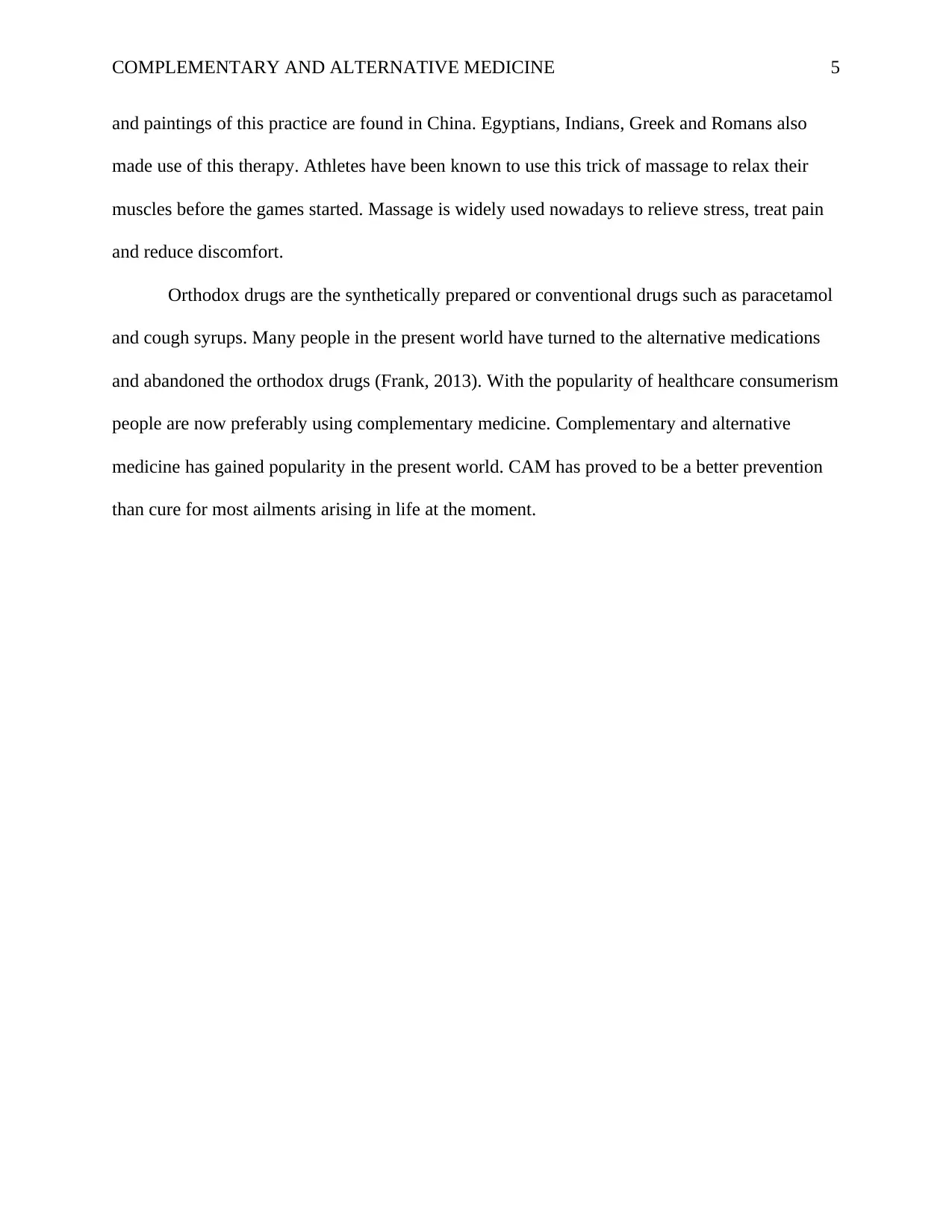
COMPLEMENTARY AND ALTERNATIVE MEDICINE 5
and paintings of this practice are found in China. Egyptians, Indians, Greek and Romans also
made use of this therapy. Athletes have been known to use this trick of massage to relax their
muscles before the games started. Massage is widely used nowadays to relieve stress, treat pain
and reduce discomfort.
Orthodox drugs are the synthetically prepared or conventional drugs such as paracetamol
and cough syrups. Many people in the present world have turned to the alternative medications
and abandoned the orthodox drugs (Frank, 2013). With the popularity of healthcare consumerism
people are now preferably using complementary medicine. Complementary and alternative
medicine has gained popularity in the present world. CAM has proved to be a better prevention
than cure for most ailments arising in life at the moment.
and paintings of this practice are found in China. Egyptians, Indians, Greek and Romans also
made use of this therapy. Athletes have been known to use this trick of massage to relax their
muscles before the games started. Massage is widely used nowadays to relieve stress, treat pain
and reduce discomfort.
Orthodox drugs are the synthetically prepared or conventional drugs such as paracetamol
and cough syrups. Many people in the present world have turned to the alternative medications
and abandoned the orthodox drugs (Frank, 2013). With the popularity of healthcare consumerism
people are now preferably using complementary medicine. Complementary and alternative
medicine has gained popularity in the present world. CAM has proved to be a better prevention
than cure for most ailments arising in life at the moment.
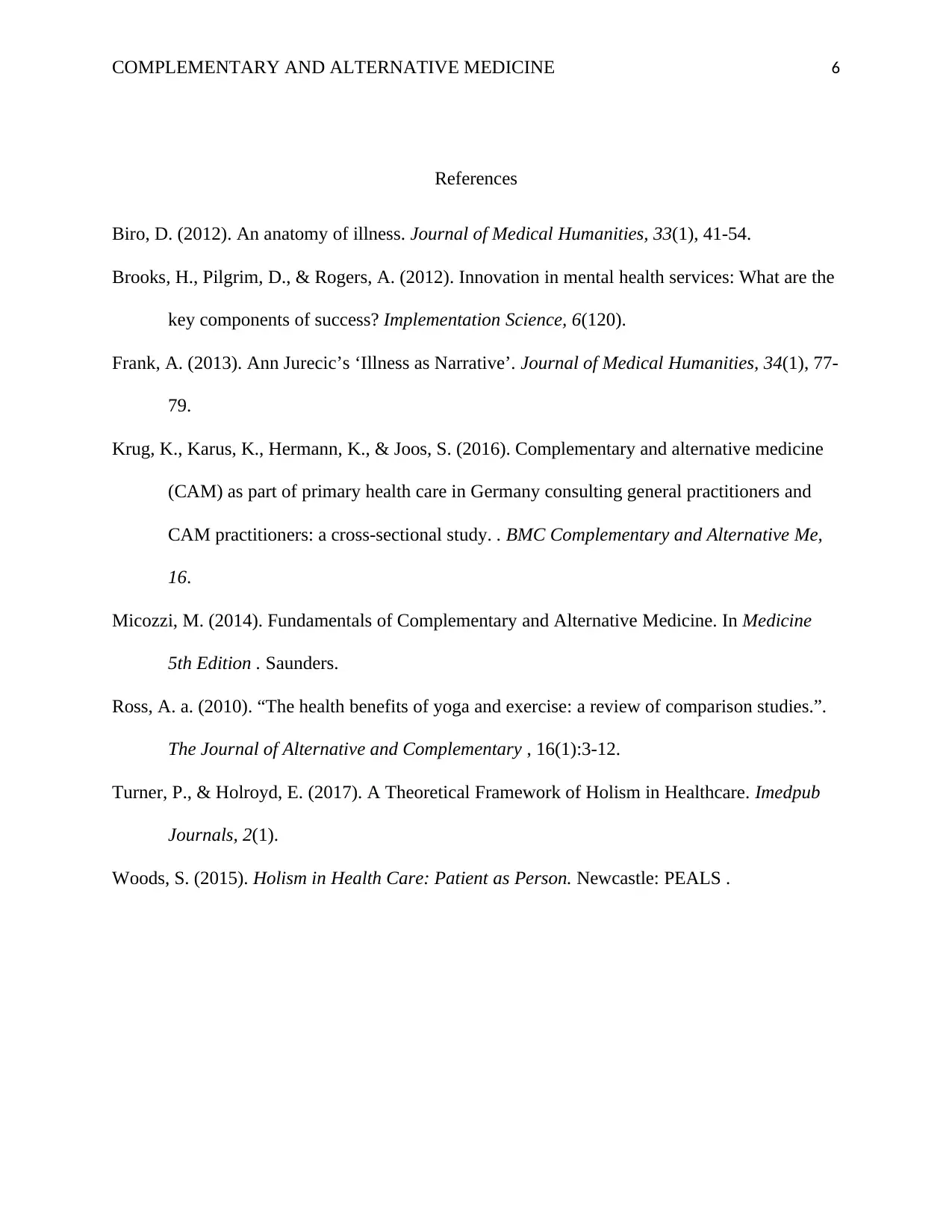
COMPLEMENTARY AND ALTERNATIVE MEDICINE 6
References
Biro, D. (2012). An anatomy of illness. Journal of Medical Humanities, 33(1), 41-54.
Brooks, H., Pilgrim, D., & Rogers, A. (2012). Innovation in mental health services: What are the
key components of success? Implementation Science, 6(120).
Frank, A. (2013). Ann Jurecic’s ‘Illness as Narrative’. Journal of Medical Humanities, 34(1), 77-
79.
Krug, K., Karus, K., Hermann, K., & Joos, S. (2016). Complementary and alternative medicine
(CAM) as part of primary health care in Germany consulting general practitioners and
CAM practitioners: a cross-sectional study. . BMC Complementary and Alternative Me,
16.
Micozzi, M. (2014). Fundamentals of Complementary and Alternative Medicine. In Medicine
5th Edition . Saunders.
Ross, A. a. (2010). “The health benefits of yoga and exercise: a review of comparison studies.”.
The Journal of Alternative and Complementary , 16(1):3-12.
Turner, P., & Holroyd, E. (2017). A Theoretical Framework of Holism in Healthcare. Imedpub
Journals, 2(1).
Woods, S. (2015). Holism in Health Care: Patient as Person. Newcastle: PEALS .
References
Biro, D. (2012). An anatomy of illness. Journal of Medical Humanities, 33(1), 41-54.
Brooks, H., Pilgrim, D., & Rogers, A. (2012). Innovation in mental health services: What are the
key components of success? Implementation Science, 6(120).
Frank, A. (2013). Ann Jurecic’s ‘Illness as Narrative’. Journal of Medical Humanities, 34(1), 77-
79.
Krug, K., Karus, K., Hermann, K., & Joos, S. (2016). Complementary and alternative medicine
(CAM) as part of primary health care in Germany consulting general practitioners and
CAM practitioners: a cross-sectional study. . BMC Complementary and Alternative Me,
16.
Micozzi, M. (2014). Fundamentals of Complementary and Alternative Medicine. In Medicine
5th Edition . Saunders.
Ross, A. a. (2010). “The health benefits of yoga and exercise: a review of comparison studies.”.
The Journal of Alternative and Complementary , 16(1):3-12.
Turner, P., & Holroyd, E. (2017). A Theoretical Framework of Holism in Healthcare. Imedpub
Journals, 2(1).
Woods, S. (2015). Holism in Health Care: Patient as Person. Newcastle: PEALS .
⊘ This is a preview!⊘
Do you want full access?
Subscribe today to unlock all pages.

Trusted by 1+ million students worldwide
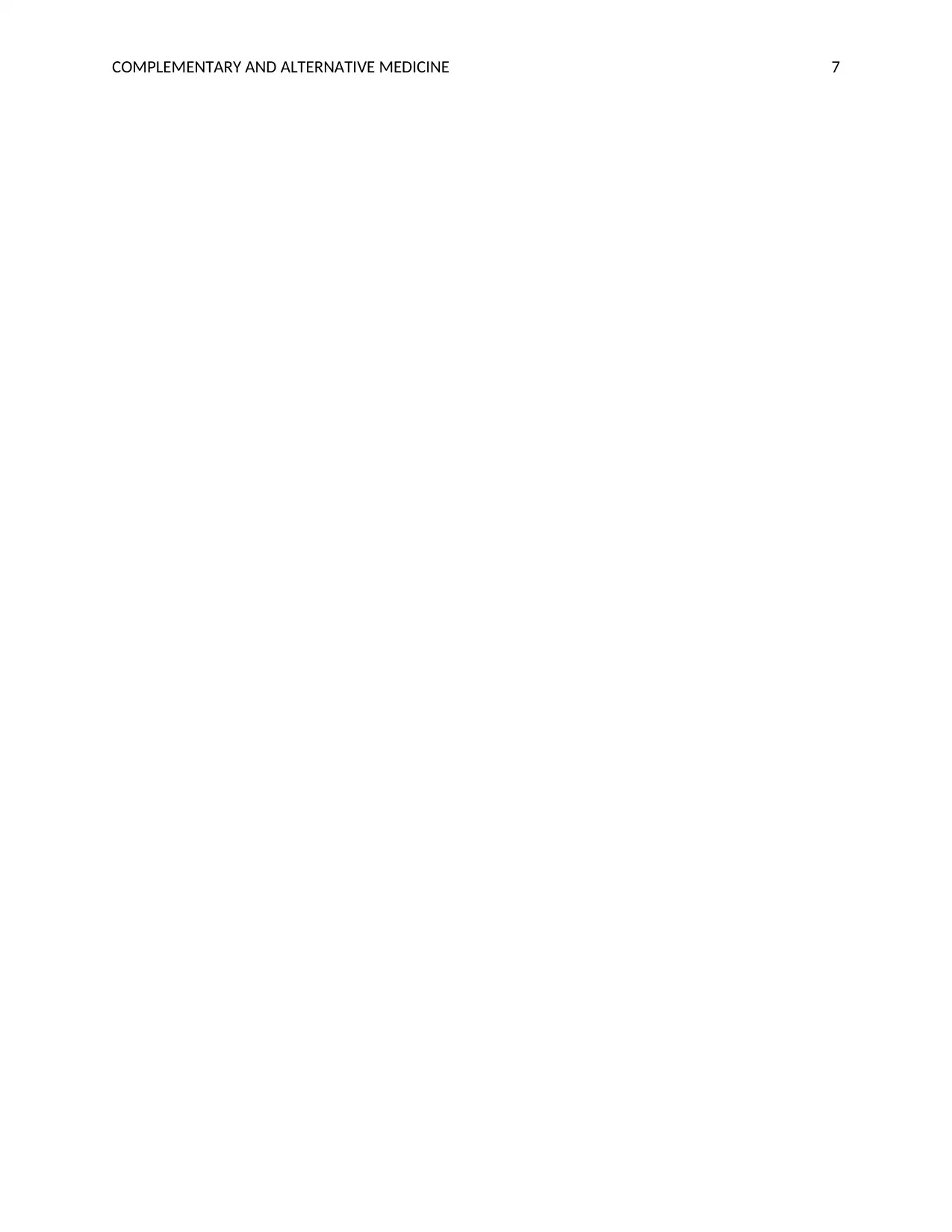
COMPLEMENTARY AND ALTERNATIVE MEDICINE 7
1 out of 7
Your All-in-One AI-Powered Toolkit for Academic Success.
+13062052269
info@desklib.com
Available 24*7 on WhatsApp / Email
![[object Object]](/_next/static/media/star-bottom.7253800d.svg)
Unlock your academic potential
Copyright © 2020–2025 A2Z Services. All Rights Reserved. Developed and managed by ZUCOL.